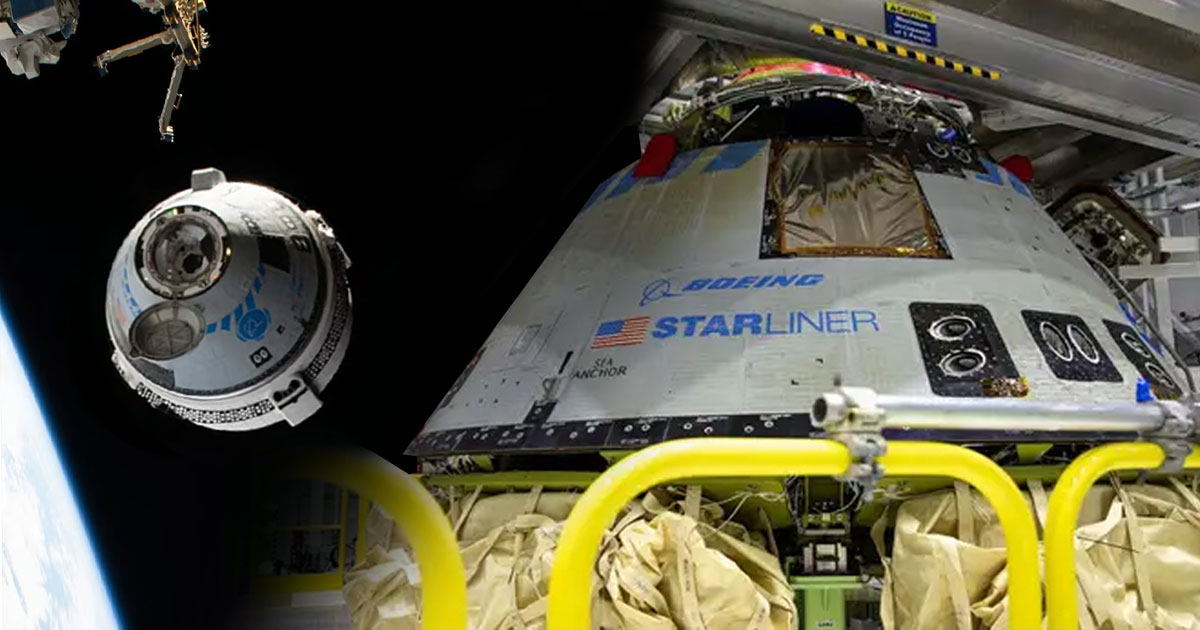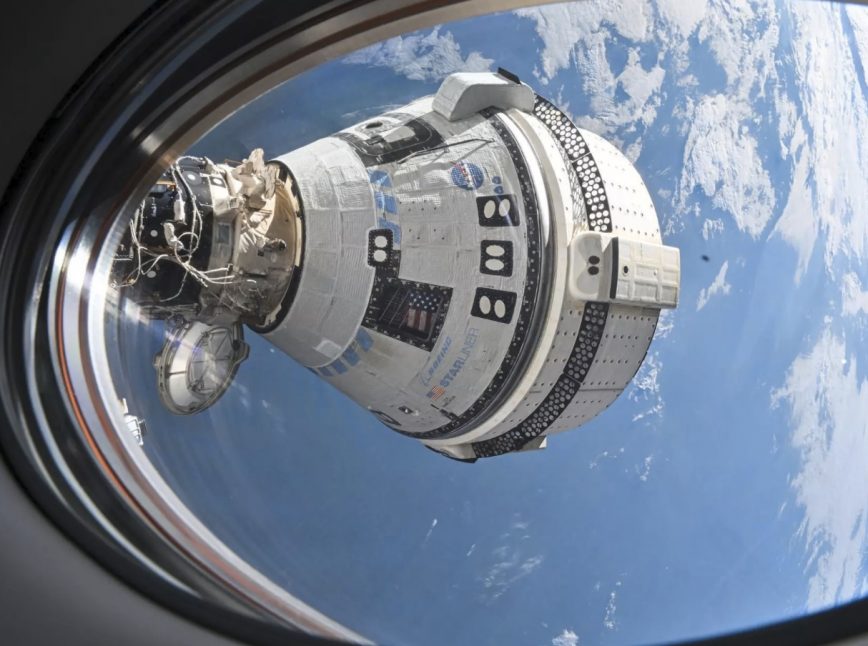New Boeing Starliner May Wreck ISS Docking Port NASA Worried

As Boeing’s Starliner spacecraft continues its troubled mission, a new concern has emerged that could have significant implications for the International Space Station (ISS). NASA, already cautious about the spacecraft’s performance, is now worried that a proposed software update to the Starliner could render the ISS docking port inoperable. This fear comes at a time when the agency is considering whether to bring the crew of the Boeing Starliner back to Earth aboard a SpaceX Crew Dragon, leaving the Starliner to return on its own.

This situation has become more complicated as NASA juggles the potential risks of a software update with the already extended timeline of the Boeing Crew Flight Test, which launched from Cape Canaveral more than two months ago. The eight-day mission has stretched far beyond its intended duration, with technical issues continuously delaying the spacecraft’s return.
Boeing’s Starliner: A Troubled Mission
The Boeing Starliner has had a rough journey since its launch. Originally part of NASA’s Commercial Crew Program, the Starliner was designed to provide a safe and reliable means of transporting astronauts to and from the ISS. However, the spacecraft has been plagued with technical difficulties that have cast doubt on its reliability and safety.
The most recent concern centers around Boeing’s decision to remove the Starliner’s autonomous undocking feature from its onboard software. This capability, crucial for the spacecraft to detach itself from the ISS and return to Earth, was successfully demonstrated during Boeing’s Orbital Flight Test 2 mission in May 2022. During that test, the Starliner autonomously docked with the ISS and returned to Earth, showing that the software could handle these critical tasks without crew intervention.
However, for reasons that Boeing has not fully explained, this feature was removed from the software for the current crewed mission. The removal of this autonomous undocking capability has left NASA in a difficult position, especially since the Starliner is currently docked at the ISS, and the only way to bring it back to Earth safely might involve pushing a software update while it’s in orbit.
The Risks of a Software Update in Space
The prospect of updating the Starliner’s software while it is docked at the ISS is fraught with risks. Any errors in the update could lead to catastrophic consequences, including the potential bricking of the ISS docking port. This would not only prevent the Starliner from undocking but could also render the port unusable for future missions, severely impacting ISS operations.
NASA is understandably cautious about this approach. The agency’s concerns are not just theoretical; software glitches have caused significant problems in past space missions. In the tightly controlled environment of space, where every system must work flawlessly, even minor software bugs can lead to major disasters. The fear is that a faulty update could leave the Starliner unable to undock, or worse, damage the ISS docking port itself, making it impossible for any spacecraft to use it in the future.
The Crew’s Dilemma: Stay or Go?
Amid these technical challenges, NASA is also considering the safety and well-being of the two astronauts currently aboard the Starliner: Barry Wilmore and Suni Williams. Originally, the plan was for these astronauts to pilot the Starliner back to Earth. However, given the uncertainties surrounding the spacecraft’s software, NASA is contemplating bringing them back aboard a SpaceX Crew Dragon instead.
This would involve delaying the upcoming SpaceX Crew-9 mission, which was initially scheduled to launch on August 18. NASA is considering pushing this date back to September 24, allowing time to determine whether the Starliner is flight-worthy. If the decision is made to bring Wilmore and Williams back on the Crew Dragon, two seats would be left empty on the spacecraft, which could be filled by the returning astronauts.
This scenario presents a unique challenge for NASA. The agency must weigh the risks of leaving the astronauts aboard the Starliner against the potential dangers of attempting a return flight without crew. There’s also the issue of what to do with the Starliner itself if it cannot be safely undocked from the ISS. In such a case, NASA might have to consider abandoning the spacecraft, a move that would represent a significant setback for Boeing and its partnership with NASA.
The Orbital Flight Test 2: A Tale of Two Missions
To understand the current dilemma, it’s important to look back at Boeing’s Orbital Flight Test 2 (OFT-2) mission, which took place in May 2022. This mission was designed as a full demonstration of the Starliner’s capabilities, including its ability to autonomously dock with the ISS and return to Earth. The OFT-2 was largely successful, with the Starliner completing its mission without major issues.
However, the Starliner used in the OFT-2 was a different vehicle from the one currently in space, and for reasons that remain unclear, Boeing decided to remove the autonomous undocking feature from the software for the current crewed mission. This decision has created a situation where NASA must now consider pushing a software update to restore this functionality, a move that could have serious implications for the ISS and the astronauts aboard.
Why Remove the Autonomous Undocking Feature?
One of the most puzzling aspects of this situation is why Boeing removed the autonomous undocking feature from the Starliner’s software in the first place. This feature was proven to work during the OFT-2 mission, so its removal seems counterintuitive, especially for a crewed mission where safety and reliability are paramount.
Boeing has not provided a clear explanation for this decision, leaving both NASA and the public in the dark. Speculation ranges from concerns about software stability to a desire to test different operational scenarios, but without official confirmation, the true reason remains a mystery.
What is clear is that this decision has added a layer of complexity to an already challenging mission. The need to potentially push a software update in space introduces new risks that could have been avoided if the original software had been left intact.
The Potential Impact on Future Missions
The issues surrounding the Starliner’s current mission could have far-reaching implications for both NASA and Boeing. If the Starliner is unable to return safely to Earth, or if the spacecraft damages the ISS docking port, it could delay future missions and raise questions about the viability of Boeing’s spacecraft as a reliable option for NASA’s Commercial Crew Program.
Furthermore, the potential delay of the SpaceX Crew-9 mission highlights how interconnected these missions have become. Any issue with one spacecraft can have a domino effect, impacting schedules and operations across the board. For NASA, ensuring the safety of its astronauts and the integrity of the ISS must remain the top priority, even if it means making difficult decisions about the future of the Starliner program.
The Role of SpaceX in NASA’s Plans
SpaceX’s Crew Dragon has become a vital part of NASA’s crewed spaceflight operations, providing a reliable means of transporting astronauts to and from the ISS. With the Starliner’s future in question, NASA may need to rely even more heavily on SpaceX in the coming months.
The Crew Dragon has proven itself to be a versatile and dependable spacecraft, successfully completing multiple missions since its first crewed flight in 2020. Its ability to adapt to different mission profiles, including the potential retrieval of the Starliner crew, underscores its importance to NASA’s overall strategy.
However, this increased reliance on SpaceX also highlights the need for competition and redundancy in spaceflight. NASA’s partnership with Boeing was intended to provide an alternative to SpaceX, ensuring that the agency would not be dependent on a single provider. The current issues with the Starliner serve as a reminder of the challenges involved in developing and maintaining multiple spacecraft options.
What’s Next for the Starliner?
As NASA continues to evaluate the situation, several possible scenarios could unfold. One option is to proceed with the software update, hoping that the risks can be mitigated and that the Starliner can be safely undocked and returned to Earth. This would require careful planning and coordination between NASA and Boeing to ensure that every precaution is taken.
Another option is to abandon the Starliner and focus on bringing the crew back to Earth aboard the SpaceX Crew Dragon. While this would be a significant setback for Boeing, it would prioritize the safety of the astronauts and the integrity of the ISS. The abandoned Starliner could be left in orbit or eventually deorbited in a controlled manner to ensure that it does not pose a hazard to the ISS or other spacecraft.
Regardless of the outcome, the current situation will likely prompt a thorough review of the Starliner program and its future role in NASA’s crewed spaceflight operations. The lessons learned from this mission could lead to improvements in both the Starliner and other spacecraft, helping to ensure that future missions are safer and more reliable.
The Broader Implications for Space Exploration
The challenges facing the Starliner mission are a reminder of the complexities and risks involved in space exploration. As NASA and its partners continue to push the boundaries of what is possible, they must also navigate the uncertainties that come with operating in the harsh environment of space. Photo Credit – NASA

